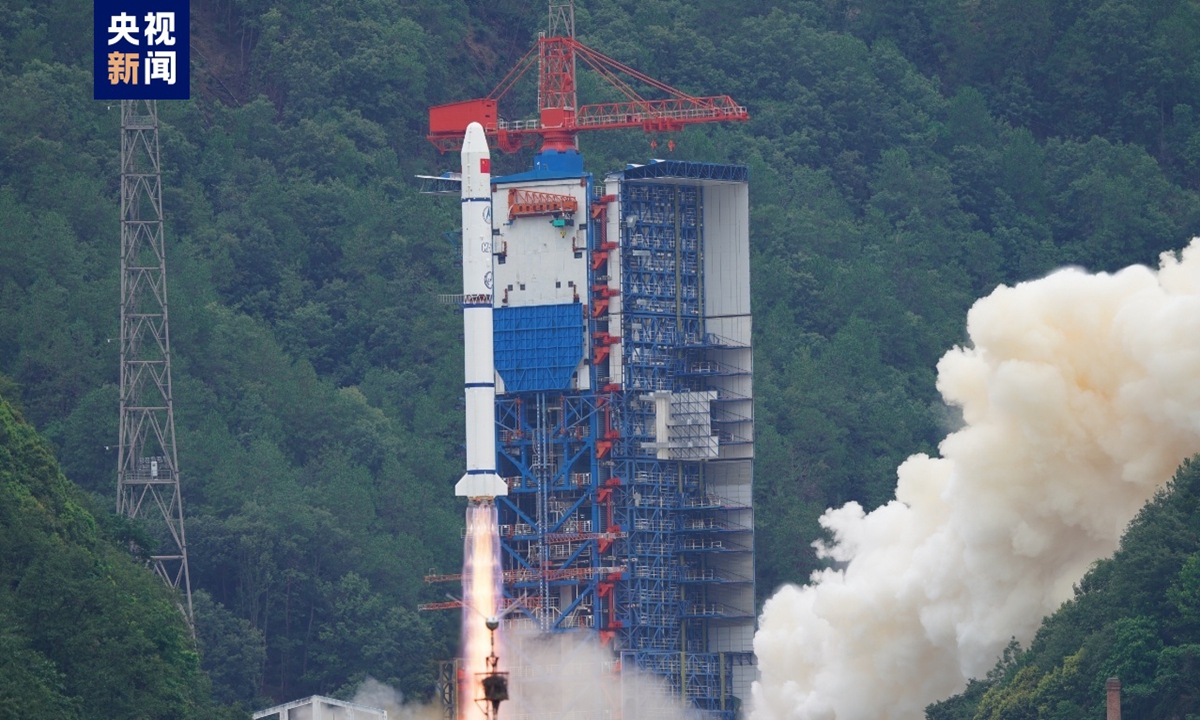China-France space science satellite launched successfully

China successfully launches the Space Variable Objects Monitor, a space science satellite co-developed by China and France, to its preset orbit at the Xichang Satellite Launch Center in Southwest China's Sichuan Province on June 22, 2024. (Photo: CCTV News)
China on Saturday successfully launched the Space Variable Objects Monitor (SVOM), a space science satellite co-developed by China and France, to its preset orbit, which according to mission insiders and space observers on Sunday, marked a hallmark example of cooperation in space between a major Western country and an Asian power.
The Global Times learned from the China National Space Administration (CNSA) that China launched the SVOM with the Long March 2C carrier rocket at the Xichang Satellite Launch Center in Southwest China's Sichuan Province at 3 pm on Saturday.
This satellite is currently the most powerful satellite in the world for multi-band comprehensive observation of gamma-ray bursts and will play a significant role in scientific discoveries in the field of space astronomy, including gamma-ray burst (GRB) research, the CNSA explained in a statement it provided to the Global Times.
The SVOM project is a collaboration forged in 2014 and the second satellite-related cooperation between China and France, following the China-France Oceanography Satellite that was launched into orbit in 2018 and became operational.
The SVOM is designed to hunt short-lived and extremely violent cosmic explosions known as gamma-ray bursts by detecting high-energy electromagnetic radiation in the X-ray and gamma-ray ranges.
To achieve this goal, Chinese scientists and engineers have developed a pair of instruments for the satellite. They are the Gamma-Ray Monitor to measure the spectrum of emissions from GRBs and Visible Telescope, which will look for light emitted in optical wavelengths immediately after a gamma-ray burst event.
Meanwhile, the French side provided ECLAIRs telescope and Microchannel X-ray Telescope onboard the SVOM.
The satellite platform where the parts are assembled onto was also developed by the Chinese side. The platform will provide high stability as well as autonomous control for the satellite during its hunting for weak signals in the universe.
The satellite is also empowered by China's BeiDou Navigation Satellite System (BDS), being able to use the BDS short message services as well as the French VHF network, so that the SVOM could transmit an alert signal back to the ground station within five minutes after it detects a GRB event, to notify ground-based large-aperture telescopes around the world as well as other GRB satellite such as the SWIFT to observe such event altogether, Global Times has learned from the project's developers.
The SVOM Chinese team told the Global Times that they were looking forward to more cooperation with their French colleagues in the future.
France has rich experience in space astronomy, oceanographic as well as atmosphere monitoring. We are hoping to deepen our cooperation with them in those fields and even in exploration of planets outside the solar system, one team member said.
This year marks the 60th anniversary of diplomatic relations between China and France. Over the past 60 years, China and France have engaged in practical cooperation in the space field, the CNSA said.
The successful implementation of the China-France SVOM project serves as an excellent example of deep cooperation in the aerospace field between the two countries, the CNSA said, while listing other milestone cooperation achieved over recent years such as the CFOSat launched in 2018 and the French radon detector onboard China's Chang'e-6 that landed on the far side of the moon in 2024.
The Western media has immediately pointed out that the SVOM project stems from a partnership between the French and Chinese space agencies as well as other scientific and technical groups from both nations. However, space cooperation at such a level between the West and China is viewed as "fairly uncommon, especially since the United States banned all collaboration between NASA and Beijing in 2011," the AFP reported.
"US concerns on technology transfer have inhibited US allies from collaborating with the Chinese very much, but it does happen occasionally," Jonathan McDowell, an astronomer from the Harvard-Smithsonian Center for Astrophysics in the US, told AFP.
So while SVOM is "by no means unique," it remains "significant" in the context of space collaboration between China and the West, McDowell added.
Chinese space observers said that the SVOM served as the latest notable example of high-level space cooperation between a Western power and China, showcasing China's openness in the space domain, in stark contrast with US domestic legislation such as the Wolf Amendment that prevents normal exchanges and dialogue between Chinese and US space agencies.
It is hoped that the US could change its course, abandon its hostile stance towards China, and give up its strategy of containing China. Only in this way can a new starting point for cooperation between China and the US in the space field be established, they said.
If the two countries can genuinely cooperate, it will be beneficial for the world and supports the building of a community with a shared future for mankind. The key is for the US to relinquish its ambition to dominate the world and abandon the series of unfriendly measures it has taken against China to achieve this ambition, they noted.
Also launched on Saturday was an experiment satellite of the Chasing All Transients Constellation Hunters mission, according to Zhang Shuangnan, a senior researcher with the Institute of High Energy Physics, Chinese Academy of Sciences, who is also one of the initiators of the SVOM project and the project's deputy chief scientist who led the development of one of the two Chinese instruments involved.
The satellite is a constellation comprising hundreds of cubesats, each equipped with lightweight LIGA-Micro-Slot-Optics designed for high-sensitivity soft X-ray focusing. The constellation includes three types of cubesats — imaging, spectral-timing, and polarization — each carrying different focal plane detectors. This mission will significantly enhance the investigation of transients such as black holes, neutron stars, and high-energy neutrinos.
Zhang told the Global Times on Sunday that the experiment satellite is also within the China-France cooperation framework and moreover, it is within the discussion of future cooperation between the two countries. "If implemented, the sky will be filled with SVOM-like satellites."
Photos
Related Stories
- Chinese rocket launches 5 satellites into space
- China's commercial CERES-1 rocket launches 3 satellites
- French artistic director makes Chinese ancient town aglow with fireworks
- China launches new astronomical satellite developed in cooperation with France
- French companies seize opportunities from China's development
- China launches new astronomical satellite developed in cooperation with France
Copyright © 2024 People's Daily Online. All Rights Reserved.









